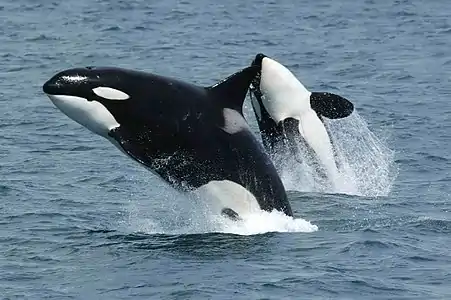List of mammals of Madagascar
This is a list of the native wild mammal species recorded in Madagascar. As of June 2014 (following the IUCN reassessment of the lemurs) there are 241 extant mammal species recognized in Madagascar, of which 22 are critically endangered, 62 are endangered, 32 are vulnerable, 9 are near threatened, 72 are of least concern and 44 are either data deficient or not evaluated. All of the critically endangered species are lemurs.[note 1]
The mammalian fauna of Madagascar is highly distinctive and largely endemic. The extant nonmarine, nonchiropteran taxa constitute (as of June 2014) 168 species, 40 genera and 9 families; of these, besides a probably introduced shrew,[note 2] endemic taxa make up all the species,[note 3] all the genera, and all but one of the families.[note 4] This endemic terrestrial fauna, consisting of lemurs, tenrecs, nesomyine rodents and euplerid carnivorans, is thought to have colonized the island from Africa via four (or five, if aye-ayes arrived separately) rafting events. The other historic terrestrial or semiterrestrial mammal group, the extinct hippopotamuses, is thought to have colonized the island possibly several times, perhaps via swimming.
Earlier in the Holocene, Madagascar had a number of megafaunal mammals: giant lemurs such as Archaeoindris which at over 200 kg was comparable in mass to the largest gorillas, as well as the hippopotamuses. The island also hosted flightless elephant birds weighing up to 700 kg, the largest known birds of all time.[note 5] All of these went extinct following the first appearance of humans about 2000 years ago.[8][9][note 6] Today, the largest surviving native mammals of the island, such as the indri[11] and fossa,[12] have weights only approaching 10 kg. Most if not all of the 29 listed extinct species are believed to have died out in prehistoric times; none of these are known to have survived into the post-European contact period.
The following tags are used to highlight each species' conservation status as assessed by the International Union for Conservation of Nature; those on the left are used here, those in the second column in some other articles:
| EX | EX | Extinct | No reasonable doubt that the last individual has died. |
| EW | EW | Extinct in the wild | Known only to survive in captivity or as a naturalized population well outside its historic range. |
| CR | CR | Critically endangered | The species is in imminent danger of extinction in the wild. |
| EN | EN | Endangered | The species is facing a very high risk of extinction in the wild. |
| VU | VU | Vulnerable | The species is facing a high risk of extinction in the wild. |
| NT | NT | Near threatened | The species does not qualify as being at high risk of extinction but is likely to do so in the future. |
| LC | LC | Least concern | The species is not currently at risk of extinction in the wild. |
| DD | DD | Data deficient | There is inadequate information to assess the risk of extinction for this species. |
| NE | NE | Not evaluated | The conservation status of the species has not been studied. |
Order: Afrosoricida (tenrecs, otter shrews and golden moles)
The afrotherian order Afrosoricida contains the golden moles and otter shrews of sub-Saharan Africa and the tenrecs of Madagascar, families of small mammals that were traditionally part of the order Insectivora. All native tenrecs of Madagascar are believed to descend from a common ancestor that lived 29–37 million years (Ma) ago[13][14][15] after rafting from Africa,[16][17] with the split from their closest relatives, the otter shrews of equatorial Africa, dated to about 47–53 Ma ago.[13][14][15]
Afrosoricida also contains the enigmatic extinct genus Plesiorycteropus, represented by two extinct species of dog-sized, probably insectivorous mammals restricted to Madagascar. Morphological analyses have tended to place them within Afrotheria close to aardvarks (order Tubulidentata),[18] perhaps due to convergent specializations for digging.[19] Analysis of preserved collagen sequences, however, places them in Afrosoricida closest to (and possibly within) tenrecs.[20] The two species differ in size and aspects of morphology.[19] They survived until as recently as 2150 BP.[9]
- Family: Tenrecidae (tenrecs)
- Subfamily: Geogalinae
- Genus: Geogale
- Large-eared tenrec, Geogale aurita LC
- Genus: Geogale
- Subfamily: Oryzorictinae
- Genus: Microgale
- Short-tailed shrew tenrec, Microgale brevicaudata LC
- Cowan's shrew tenrec, Microgale cowani LC
- Drouhard's shrew tenrec, Microgale drouhardi LC
- Dryad shrew tenrec, Microgale dryas VU
- Pale shrew tenrec, Microgale fotsifotsy LC
- Gracile shrew tenrec, Microgale gracilis LC
- Grandidier's shrew tenrec, Microgale grandidieri LC
- Naked-nosed shrew tenrec, Microgale gymnorhyncha LC
- Jenkins's shrew tenrec, Microgale jenkinsae EN
- Northern shrew tenrec, Microgale jobihely EN
- Lesser long-tailed shrew tenrec, Microgale longicaudata LC
- Microgale macpheei EX (PH)
- Major's long-tailed tenrec, (Microgale majori) LC
- Web-footed tenrec, Microgale mergulus VU
- Montane shrew tenrec, Microgale monticola VU
- Nasolo's shrew tenrec, Microgale nasoloi VU
- Pygmy shrew tenrec, Microgale parvula LC
- Greater long-tailed shrew tenrec, Microgale principula LC
- Least shrew tenrec, Microgale pusilla LC
- Shrew-toothed shrew tenrec, Microgale soricoides LC
- Taiva shrew tenrec, Microgale taiva LC
- Thomas's shrew tenrec, Microgale thomasi LC
- Genus: Nesogale
- Dobson's shrew tenrec, Nesogale dobsoni LC
- Talazac's shrew tenrec, Nesogale talazaci LC
- Genus: Oryzorictes
- Mole-like rice tenrec, Oryzorictes hova LC
- Four-toed rice tenrec, Oryzorictes teradactylus DD
- Genus: Microgale
- Subfamily: Tenrecinae
- Genus: Echinops
- Lesser hedgehog tenrec, Echinops telfairi LC
- Genus: Hemicentetes
- Highland streaked tenrec, Hemicentetes nigriceps LC
- Lowland streaked tenrec, Hemicentetes semispinosus LC
- Genus: Setifer
- Greater hedgehog tenrec, Setifer setosus LC
- Genus: Tenrec
- Tailless tenrec, Tenrec ecaudatus LC
- Genus: Echinops
- Subfamily: Geogalinae
- Incertae familiae: Genus: †Plesiorycteropus
Order: Sirenia (manatees and dugongs)
Sirenia is an order of fully aquatic, herbivorous mammals that inhabit rivers, estuaries, coastal marine waters, swamps, and marine wetlands. All four species are endangered. The dugong ranges widely along coastlines from east Africa to Australasia. It and the tenrecs are Madagascar's only extant afrotherians.
- Family: Dugongidae
Order: Primates
The order Primates contains all the species commonly related to the lemurs, monkeys, and apes, with the latter category including humans. It is divided into four main groupings: strepsirrhines, tarsiers, monkeys of the New World, and monkeys and apes of the Old World. Strepsirrhines make up all of Madagascar's native primates species, but comprise only a quarter of those of Africa, the rest being simians. Madagascar's strepsirrhines occupy both diurnal and nocturnal niches, while all those of Asia and mainland Africa are nocturnal[21] and nearly all simians are diurnal (the only exception being neotropical Aotus, which lives where strepsirrhines are absent).[22] Madagascar's 15 genera of extant nonhuman primates compares with 6 in Central America, 20 in South America, 23 in Africa and 19 in Asia. A number of lemur species larger than any now alive, ranging in size up to that of a gorilla, are believed to have become extinct shortly after the recent arrival of humans.
The endemic primates of Madagascar, the lemurs, constitute a single clade and are the largest branch of strepsirrhines. It has been proposed that a common ancestor of all Madagascar's lemurs rafted across the Mozambique Channel from Africa[23][24][note 7] between 50 and 60 million years ago.[16][17] However, findings of similarities in dentition between several African primate fossils and aye-ayes, the most basal of lemurs, have led to the alternate proposal that the ancestors of aye-ayes colonized Madagascar separately from other lemurs.[25]
Between 2000 and 2008, 39 new lemur species were described, bringing the total number of recognized species and subspecies to 99;[26] by 2014, the number of extant species and subspecies recognized had increased to 105. Of these, the IUCN classified 24 as critically endangered, 49 as endangered, 20 as vulnerable, three as near threatened, three as of least concern and four as data deficient; two were yet to be evaluated.
- Suborder: Strepsirrhini
- Infraorder: Lemuriformes
- Family: †Archaeolemuridae (monkey lemurs)
- Genus: †Archaeolemur
- Archaeolemur edwardsi EX (PH)
- Archaeolemur majori EX (PH)
- Genus: †Hadropithecus
- Hadropithecus stenognathus EX (PH)
- Genus: †Archaeolemur
- Family: Cheirogaleidae
- Genus: Allocebus
- Hairy-eared dwarf lemur, Allocebus trichotis EN
- Genus: Cheirogaleus
- Montagne d'Ambre dwarf lemur, Cheirogaleus andysabini EN
- Furry-eared dwarf lemur, Cheirogaleus crossleyi VU
- Groves' dwarf lemur, Cheirogaleus grovesi DD
- Lavasoa dwarf lemur, Cheirogaleus lavasoensis EN
- Greater dwarf lemur, Cheirogaleus major VU
- Fat-tailed dwarf lemur, Cheirogaleus medius VU
- Lesser iron-gray dwarf lemur, Cheirogaleus minusculus NE
- Ankarana dwarf lemur, Cheirogaleus shethi EN
- Sibree's dwarf lemur, Cheirogaleus sibreei CR
- Genus: Microcebus
- Arnhold's mouse lemur, Microcebus arnholdi VU
- Madame Berthe's mouse lemur, Microcebus berthae CR
- Bongolava mouse lemur, Microcebus bongolavensis EN
- Boraha mouse lemur, Microcebus boraha DD
- Danfoss' mouse lemur, Microcebus danfossi VU
- Ganzhorn's mouse lemur, Microcebus ganzhorni EN
- Gerp's mouse lemur, Microcebus gerpi CR
- Reddish-gray mouse lemur, Microcebus griseorufus LC
- Jolly's mouse lemur, Microcebus jollyae EN
- Goodman's mouse lemur, Microcebus lehilahytsara VU
- MacArthur's mouse lemur, Microcebus macarthurii EN
- Claire's mouse lemur, Microcebus mamiratra EN
- Manitatra mouse lemur, Microcebus manitatra CR
- Margot Marsh's mouse lemur, Microcebus margotmarshae EN
- Marohita mouse lemur, Microcebus marohita CR
- Mittermeier's mouse lemur, Microcebus mittermeieri EN
- Gray mouse lemur, Microcebus murinus NE
- Pygmy mouse lemur, Microcebus myoxinus VU
- Golden-brown mouse lemur, Microcebus ravelobensis VU
- Brown mouse lemur, Microcebus rufus VU
- Sambirano mouse lemur, Microcebus sambiranensis EN
- Simmons' mouse lemur, Microcebus simmonsi NE
- Anosy mouse lemur, Microcebus tanosi EN
- Northern rufous mouse lemur, Microcebus tavaratra VU
- Genus: Mirza
- Coquerel's giant mouse lemur, Mirza coquereli EN
- Northern giant mouse lemur, Mirza zaza VU
- Genus: Phaner
- Amber Mountain fork-marked lemur, Phaner electromontis EN
- Masoala fork-marked lemur, Phaner furcifer EN
- Pale fork-marked lemur, Phaner pallescens EN
- Pariente's fork-marked lemur, Phaner parienti EN
- Genus: Allocebus
- Family: Daubentoniidae
- Genus: Daubentonia
- Aye-aye, Daubentonia madagascariensis EN
- Giant aye-aye, Daubentonia robusta EX (PH)
- Genus: Daubentonia
- Family: Indriidae
- Genus: Avahi
- Betsileo woolly lemur, Avahi betsileo EN
- Bemaraha woolly lemur, Avahi cleesei CR
- Eastern woolly lemur, Avahi laniger VU
- Southern woolly lemur, Avahi meridionalis EN
- Moore's woolly lemur, Avahi mooreorum EN
- Western woolly lemur, Avahi occidentalis VU
- Peyrieras's woolly lemur, Avahi peyrierasi VU
- Ramanantsoavana's woolly lemur, Avahi ramanantsoavanai VU
- Sambirano woolly lemur, Avahi unicolor CR
- Genus: Indri
- Indri, Indri indri CR
- Genus: Propithecus
- Silky sifaka, Propithecus candidus CR
- Coquerel's sifaka, Propithecus coquereli CR
- Crowned sifaka, Propithecus coronatus CR
- Von der Decken's sifaka, Propithecus deckenii CR
- Diademed sifaka, Propithecus diadema CR
- Milne-Edwards's sifaka, Propithecus edwardsi EN
- Perrier's sifaka, Propithecus perrieri CR
- Golden-crowned sifaka, Propithecus tattersalli CR
- Verreaux's sifaka, Propithecus verreauxi CR
- Genus: Avahi
- Family: Lemuridae (large lemurs)
- Genus: Eulemur
- White-headed lemur, Eulemur albifrons VU
- Gray-headed lemur, Eulemur cinereiceps CR
- Collared brown lemur, Eulemur collaris EN
- Crowned lemur, Eulemur coronatus EN
- Blue-eyed black lemur, Eulemur flavifrons CR
- Common brown lemur, Eulemur fulvus VU
- Black lemur, Eulemur macaco EN
- Mongoose lemur, Eulemur mongoz CR
- Red-bellied lemur, Eulemur rubriventer VU
- Red-fronted lemur, Eulemur rufifrons VU
- Red lemur, Eulemur rufus VU
- Sanford's brown lemur, Eulemur sanfordi EN
- Genus: Hapalemur
- Lac Alaotra bamboo lemur, Hapalemur alaotrensis CR
- Golden bamboo lemur, Hapalemur aureus CR
- Eastern lesser bamboo lemur, Hapalemur griseus VU
- Beanamalao bamboo lemur, Hapalemur griseus gilberti DD
- Eastern lesser bamboo lemur, Hapalemur griseus griseus VU
- Ranomafana bamboo lemur, Hapalemur griseus ranomafanensis VU
- Southern lesser bamboo lemur, Hapalemur meridionalis VU
- Western lesser bamboo lemur, Hapalemur occidentalis VU
- Genus: Lemur
- Ring-tailed lemur, Lemur catta EN
- Genus: †Pachylemur
- Pachylemur insignis EX (PH)
- Pachylemur jullyi EX (PH)
- Genus: Prolemur
- Greater bamboo lemur, Prolemur simus CR
- Genus: Varecia
- Red ruffed lemur, Varecia rubra CR
- Black-and-white ruffed lemur, Varecia variegata CR
- Southern black-and-white ruffed lemur, Varecia variegata editorum CR
- White-belted black-and-white ruffed lemur, Varecia variegata subcincta CR
- Black-and-white ruffed lemur, Varecia variegata variegata CR
- Genus: Eulemur
- Family: Lepilemuridae
- Genus: Lepilemur
- Antafia sportive lemur, Lepilemur aeeclis EN
- Ahmanson's sportive lemur, Lepilemur ahmansonorum CR
- Ankarana sportive lemur, Lepilemur ankaranensis EN
- Betsileo sportive lemur, Lepilemur betsileo EN
- Gray-backed sportive lemur, Lepilemur dorsalis EN
- Milne-Edwards' sportive lemur, Lepilemur edwardsi EN
- Fleurete's sportive lemur, Lepilemur fleuretae EN
- Grewcock's sportive lemur, Lepilemur grewcockorum CR
- Holland's sportive lemur, Lepilemur hollandorum CR
- Hubbard's sportive lemur, Lepilemur hubbardorum EN
- James' sportive lemur, Lepilemur jamesorum CR
- White-footed sportive lemur, Lepilemur leucopus EN
- Small-toothed sportive lemur, Lepilemur microdon EN
- Daraina sportive lemur, Lepilemur milanoii EN
- Mittermeier's sportive lemur, Lepilemur mittermeieri CR
- Weasel sportive lemur, Lepilemur mustelinus VU
- Otto's sportive lemur, Lepilemur otto EN
- Petter's sportive lemur, Lepilemur petteri EN
- Randrianasolo's sportive lemur, Lepilemur randrianasoloi EN
- Red-tailed sportive lemur, Lepilemur ruficaudatus CR
- Sahamalaza sportive lemur, Lepilemur sahamalazensis CR
- Scott's sportive lemur, Lepilemur scottorum EN
- Seal's sportive lemur, Lepilemur seali VU
- Northern sportive lemur, Lepilemur septentrionalis CR
- Hawks' sportive lemur, Lepilemur tymerlachsonorum CR
- Wright's sportive lemur, Lepilemur wrightae EN
- Genus: Lepilemur
- Family: †Megaladapidae (koala lemurs)
- Genus: †Megaladapis
- Megaladapis edwardsi EX (PH)
- Megaladapis madagascariensis EX (PH)
- Megaladapis grandidieri EX (PH)
- Genus: †Megaladapis
- Family: †Palaeopropithecidae (sloth lemurs)
- Genus: †Archaeoindris
- Genus: †Babakotia
- Babakotia radofilai EX (PH)
- Genus: †Mesopropithecus
- Mesopropithecus dolichobrachion EX (PH)
- Mesopropithecus globiceps EX (PH)
- Mesopropithecus pithecoides EX (PH)
- Genus: †Palaeopropithecus (large sloth lemurs)
- Palaeopropithecus ingens EX (PH)
- Palaeopropithecus maximus EX (PH)
- Palaeopropithecus kelyus EX (PH)
- Family: †Archaeolemuridae (monkey lemurs)
- Infraorder: Lemuriformes
Order: Rodentia (rodents)
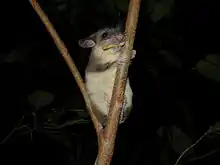
Rodents make up the largest order of mammals, with over 40% of mammalian species. They have two incisors in the upper and lower jaw which grow continually and must be kept short by gnawing. Most rodents are small though the capybara can weigh up to 45 kg (99 lb). All the native nesomyid rodents of Madagascar are believed to descend from a common ancestor that rafted over from Africa 20–24 million years ago.[16][17] There are about 39 nesomyid species in five subfamilies in Africa, compared to 27 in one subfamily extant in Madagascar. While nesomyids make up all of the native rodent species of Madagascar, they constitute less than 10% of those of Africa.
- Suborder: Sciurognathi
- Family: Nesomyidae
- Subfamily: Nesomyinae
- Genus: Brachytarsomys
- White-tailed antsangy, Brachytarsomys albicauda LC
- Brachytarsomys mahajambaensis EX
- Hairy-tailed antsangy, Brachytarsomys villosa VU
- Genus: Brachyuromys
- Betsileo short-tailed rat, Brachyuromys betsileoensis LC
- Gregarious short-tailed rat, Brachyuromys ramirohitra LC
- Genus: Eliurus
- Tsingy tufted-tailed rat, Eliurus antsingy DD
- Ankarana Special Reserve tufted-tailed rat, Eliurus carletoni
- Daniel's tufted-tailed rat, Eliurus danieli LC
- Ellerman's tufted-tailed rat, Eliurus ellermani DD
- Grandidier's tufted-tailed rat, Eliurus grandidieri LC
- Major's tufted-tailed rat, Eliurus majori LC
- Lesser tufted-tailed rat, Eliurus minor LC
- Dormouse tufted-tailed rat, Eliurus myoxinus LC
- White-tipped tufted-tailed rat, Eliurus penicillatus EN
- Petter's tufted-tailed rat, Eliurus petteri EN
- Tanala tufted-tailed rat, Eliurus tanala LC
- Webb's tufted-tailed rat, Eliurus webbi LC
- Genus: Gymnuromys
- Voalavoanala, Gymnuromys roberti LC
- Genus: Hypogeomys
- Malagasy giant rat, Hypogeomys antimena EN
- Hypogeomys australis EX
- Genus: Macrotarsomys
- Bastard big-footed mouse, Macrotarsomys bastardi LC
- Greater big-footed mouse, Macrotarsomys ingens EN
- Petter's big-footed mouse, Macrotarsomys petteri DD
- Genus: Monticolomys
- Malagasy mountain mouse, Monticolomys koopmani LC
- Genus: Nesomys
- White-bellied nesomys, Nesomys audeberti LC
- Western nesomys, Nesomys lambertoni EN
- Nesomys narindaensis EX
- Island mouse, Nesomys rufus LC
- Genus: Voalavo
- Eastern voalavo, Voalavo antsahabensis EN
- Naked-tailed voalavo, Voalavo gymnocaudus LC
- Genus: Brachytarsomys
- Subfamily: Nesomyinae
- Family: Nesomyidae
Order: Eulipotyphla (shrews, hedgehogs, moles, and solenodons)
Eulipotyphlans are insectivorous mammals. Shrews and solenodons closely resemble mice, hedgehogs carry spines, while moles are stout-bodied burrowers. There is one species of shrew on Madagascar, which is often considered to be conspecific with the widely distributed Etruscan shrew, Suncus etruscus, and likely to have been introduced to Madagascar from South or Southeast Asia by humans.[27]
- Family: Soricidae (shrews)
- Subfamily: Crocidurinae
- Genus: Suncus
- Madagascan pygmy shrew, Suncus madagascariensis LC
- Genus: Suncus
- Subfamily: Crocidurinae
Order: Chiroptera (bats)
The bats' most distinguishing feature is that their forelimbs are developed as wings, making them the only mammals capable of flight. Bat species account for about 20% of all mammals. Of the 46 species, 22 genera and 8 families of bats present on Madagascar, 36 species but only Myzopoda and Myzopodidae are endemic (the family was formerly present, however, on the African mainland). Paratriaenops is endemic to Madagascar plus the Seychelles.
- Family: Pteropodidae (flying foxes, Old World fruit bats)
- Subfamily: Pteropodinae
- Genus: Eidolon
- Madagascan fruit bat, Eidolon dupreanum VU
- Genus: Pteropus
- Madagascan flying fox, Pteropus rufus VU
- Genus: Rousettus
- Madagascan rousette, Rousettus madagascariensis VU
- Genus: Eidolon
- Subfamily: Pteropodinae
- Family: Vespertilionidae
- Subfamily: Myotinae
- Genus: Myotis
- Malagasy mouse-eared bat, Myotis goudoti LC
- Genus: Myotis
- Subfamily: Vespertilioninae
- Genus: Hypsugo
- Anchieta's pipistrelle, Hypsugo anchietae LC
- Genus: Neoromicia
- Isalo serotine, Neoromicia malagasyensis VU
- Malagasy serotine, Neoromicia matroka LC
- Neoromicia robertsi DD
- Genus: Pipistrellus
- Dusky pipistrelle, Pipistrellus hesperidus LC
- Racey's pipistrelle, Pipistrellus raceyi DD
- Genus: Scotophilus
- Lesser yellow bat, Scotophilus borbonicus DD
- Marovaza house bat, Scotophilus marovaza LC
- Robust yellow bat, Scotophilus robustus LC
- Western yellow bat, Scotophilus tandrefana DD
- Genus: Hypsugo
- Subfamily: Myotinae
- Family: Miniopteridae
- Genus: Miniopterus
- Miniopterus aelleni LC
- Miniopterus brachytragos LC
- Eger's long-fingered bat, Miniopterus egeri LC
- Glen's long-fingered bat, Miniopterus gleni LC
- Griffith's long-fingered bat, Miniopterus griffithsi DD
- Miniopterus griveaudi DD
- Miniopterus mahafaliensis LC
- Major's long-fingered bat, Miniopterus majori LC
- Manavi long-fingered bat, Miniopterus manavi LC
- Peterson's long-fingered bat, Miniopterus petersoni DD
- Sororcula long-fingered bat, Miniopterus sororculus LC
- Genus: Miniopterus
- Family: Molossidae
- Genus: Chaerephon
- Chaerephon atsinanana LC
- Black and red free-tailed bat, Chaerephon jobimena LC
- Grandidier's free-tailed bat, Chaerephon leucogaster LC
- Genus: Mops
- Malagasy white-bellied free-tailed bat, Mops leucostigma LC
- Midas free-tailed bat, Mops midas LC
- Genus: Mormopterus
- Peter's wrinkle-lipped bat, Mormopterus jugularis LC
- Genus: Otomops
- Madagascar free-tailed bat, Otomops madagascariensis LC
- Genus: Tadarida
- Madagascan large free-tailed bat, Tadarida fulminans LC
- Genus: Chaerephon
- Family: Emballonuridae
- Genus: Coleura
- African sheath-tailed bat, Coleura afra LC
- Genus: Emballonura
- Peters's sheath-tailed bat, Emballonura atrata LC
- Genus: Paremballonura
- Western sheath-tailed bat, Paremballonura tiavato LC
- Genus: Taphozous
- Mauritian tomb bat, Taphozous mauritianus LC
- Genus: Coleura
- Family: Nycteridae
- Genus: Nycteris
- Malagasy slit-faced bat, Nycteris madagascariensis DD
- Genus: Nycteris
- Family: Hipposideridae
- Genus: Hipposideros
- Genus: Macronycteris
- Commerson's roundleaf bat, Macronycteris commersoni NT
- Macronycteris cryptovalorona DD[28]
- Genus: Paratriaenops
- Grandidier's trident bat, Paratriaenops auritus VU
- Trouessart's trident bat, Paratriaenops furculus LC
- Genus: Triaenops
- Family: Myzopodidae
- Genus: Myzopoda
- Madagascar sucker-footed bat, Myzopoda aurita LC
- Western sucker-footed bat, Myzopoda schliemanni LC
- Genus: Myzopoda
Order: Carnivora (carnivorans)
There are over 260 species of carnivorans, the majority of which feed primarily on meat. They have a characteristic skull shape and dentition. The native terrestrial carnivorans of Madagascar are all euplerids, which are believed to descend from a common ancestor that rafted over from Africa 19–26 million years ago.[17] Their closest relatives are the herpestids, the African and Eurasian mongooses. Malagasy mongooses are not "true" mongooses but rather are thought to represent an example of convergent or parallel evolution. About 30% of African terrestrial carnivoran species are herpestids.
- Suborder: Feliformia
- Family: Eupleridae
- Subfamily: Euplerinae
- Genus: Cryptoprocta
- Fossa, Cryptoprocta ferox VU
- Giant fossa, Cryptoprocta spelea EX (PH)
- Genus: Eupleres
- Eastern falanouc, Eupleres goudotii VU
- Western falanouc, Eupleres major EN[29]
- Genus: Fossa
- Malagasy civet, Fossa fossana VU
- Genus: Cryptoprocta
- Subfamily: Galidiinae
- Genus: Galidia
- Ring-tailed vontsira, Galidia elegans LC
- Genus: Galidictis
- Broad-striped Malagasy mongoose, Galidictis fasciata VU
- Grandidier's vontsira, Galidictis grandidieri EN
- Genus: Mungotictis
- Narrow-striped mongoose, Mungotictis decemlineata EN
- Genus: Salanoia
- Brown-tailed mongoose, Salanoia concolor VU
- Durrell's vontsira, Salanoia durrelli NE
- Genus: Galidia
- Subfamily: Euplerinae
- Family: Eupleridae
- Suborder: Caniformia
- Clade Pinnipedia (seals, sea lions and walruses)
- Family: Otariidae (eared seals, sealions)
- Genus: Arctocephalus
- Subantarctic fur seal, Arctocephalus tropicalis LC
- Genus: Arctocephalus
- Family: Otariidae (eared seals, sealions)
- Clade Pinnipedia (seals, sea lions and walruses)
Order: Artiodactyla (even-toed ungulates and cetaceans)
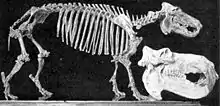
The even-toed ungulates are ungulates whose weight is borne about equally by the third and fourth toes, rather than mostly or entirely by the third as in perissodactyls. There are about 220 noncetacean artiodactyl species, including many that are of great economic importance to humans. Madagascar's only native artiodactyls are the extinct Malagasy hippos, which are believed to have descended from ancestors that managed to cross the Mozambique Channel from Africa in the late Quaternary, perhaps by swimming.[17] Two or three hippo colonization events may have occurred. H. lemerlei is thought to be a dwarfed form of Africa's H. amphibius, while H. laloumena was larger. C. madagascariensis may be more closely related to the African pygmy hippopotamus, C. liberiensis (the generic assignment of both pygmy forms has been in flux). Skeletal features indicate that Malagasy hippos were better adapted for running than African hippos. H. lemerlei remains have been found in the rivers and lakes of western Madagascar, suggesting a semiaquatic lifestyle similar to that of H. amphibious, while many C. madagascariensis remains have found in Madagascar's forested highlands, indicating a more terrestrial lifestyle.
- Family: Hippopotamidae (hippopotamuses)
- Genus: Choeropsis
- Malagasy pygmy hippopotamus, Choeropsis madagascariensis EX (PH)
- Genus: Hippopotamus
- Lesser Malagasy hippopotamus, Hippopotamus laloumena EX (PH)
- Malagasy dwarf hippopotamus, Hippopotamus lemerlei EX (PH)
- Genus: Choeropsis
Order: Cetacea (whales, dolphins and porpoises)
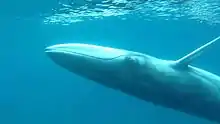
.jpg.webp)
The infraorder Cetacea includes whales, dolphins and porpoises. They are the mammals most fully adapted to aquatic life with a spindle-shaped nearly hairless body, protected by a thick layer of blubber, and forelimbs and tail modified to provide propulsion underwater. Their closest extant relatives are the hippos, which are artiodactyls, from which cetaceans descended; cetaceans are thus also artiodactyls.
- Parvorder: Mysticeti
- Family: Balaenopteridae
- Subfamily: Balaenopterinae
- Genus: Balaenoptera
- Common minke whale, Balaenoptera acutorostrata LC
- Antarctic minke whale, Balaenoptera bonaerensis DD
- Southern sei whale, Balaenoptera borealis schlegelii EN for B. borealis
- Bryde's whale, Balaenoptera edeni DD
- Pygmy blue whale, Balaenoptera musculus brevicauda DD
- Southern blue whale, Balaenoptera musculus intermedia EN for B. musculus
- Omura's whale, Balaenoptera omurai DD (among the most common rorquals of north-western Madagascar[30])
- Southern fin whale, Balaenoptera physalus quoyi EN for B. physalus
- Genus: Balaenoptera
- Subfamily: Megapterinae
- Genus: Megaptera
- Humpback whale, Megaptera novaeangliae LC
- Genus: Megaptera
- Subfamily: Balaenopterinae
- Family: Cetotheriidae
- Subfamily: Neobalaeninae
- Genus: Caperea
- Pygmy right whale, Caperea marginata LC[31]
- Genus: Caperea
- Subfamily: Neobalaeninae
- Family: Balaenidae
- Genus: Eubalaena
- Southern right whale, Eubalaena australis LC (still rare in Madagascar)
- Genus: Eubalaena
- Family: Balaenopteridae
- Parvorder: Odontoceti
- Family: Physeteridae
- Genus: Physeter
- Sperm whale, Physeter macrocephalus VU
- Genus: Physeter
- Family: Kogiidae
- Genus: Kogia
- Pygmy sperm whale, Kogia breviceps DD
- Dwarf sperm whale, Kogia sima DD
- Genus: Kogia
- Family: Ziphidae
- Genus: Indopacetus
- Tropical bottlenose whale, Indopacetus pacificus DD
- Genus: Ziphius
- Cuvier's beaked whale, Ziphius cavirostris LC
- Subfamily: Hyperoodontinae
- Genus: Mesoplodon
- Blainville's beaked whale, Mesoplodon densirostris DD
- Gray's beaked whale, Mesoplodon grayi DD
- Hector's beaked whale, Mesoplodon hectori DD
- Layard's beaked whale, Mesoplodon layardii DD
- True's beaked whale, Mesoplodon mirus DD
- Genus: Mesoplodon
- Genus: Indopacetus
- Superfamily: Delphinoidea
- Family: Delphinidae (marine dolphins)
- Genus: Steno
- Rough-toothed dolphin, Steno bredanensis LC
- Genus: Grampus
- Risso's dolphin, Grampus griseus LC
- Genus: Globicephala
- Short-finned pilot whale, Globicephala macrorhynchus LC
- Genus: Sousa
- Indian Ocean humpback dolphin, Sousa plumbea EN
- Genus: Tursiops
- Indo-Pacific bottlenose dolphin, Tursiops aduncus NT
- Common bottlenose dolphin, Tursiops truncatus LC
- Genus: Stenella
- Pantropical spotted dolphin, Stenella attenuata LC
- Striped dolphin, Stenella coeruleoalba LC
- Spinner dolphin, Stenella longirostris LC
- Genus: Delphinus
- Long-beaked common dolphin, Delphinus capensis DD
- Genus: Lagenodelphis
- Fraser's dolphin, Lagenodelphis hosei LC
- Genus: Peponocephala
- Melon-headed whale, Peponocephala electra LC
- Genus: Pseudorca
- False killer whale, Pseudorca crassidens NT
- Genus: Feresa
- Pygmy killer whale, Feresa attenuata LC
- Genus: Orcinus
- Orca, Orcinus orca DD
- Genus: Steno
- Family: Delphinidae (marine dolphins)
- Family: Physeteridae
Malagasy mammal names
Extinct megafauna
See also
Notes
- This list is derived from the IUCN Red List, which includes extant mammal species as well as four recently extinct species known from subfossil remains. To these have been added other species believed to have died out following the arrival of humans, as well as a few species known from Holocene remains whose extinction dates are poorly constrained. The taxonomy and naming of the individual species is based on those used in existing Wikipedia articles, supplemented by the common names and taxonomy from the IUCN, Smithsonian Institution, or University of Michigan where no Wikipedia article was available.
- The Madagascan pygmy shrew is also present on the Comoros[1] where it is thought to have been introduced.[2] It may also be present on Socotra.[3] Some authorities view it as conspecific with the widespread Etruscan shrew.[3]
- The tailless tenrec[4] and the common brown and mongoose lemurs[5][6] are also present on the Comoros; all are thought to have been introduced there.[2]
- The rodent family Nesomyidae is also present in Africa. Madagascar has nearly as many nesomyid species as Africa.
- It was long suspected that, like the native mammals, ratites reached Madagascar from Africa (possibly before the splitting of the two land masses), so that the closest relatives of elephant birds would have been ostriches. A stunning finding from ancient DNA analysis, however, is that the closest extant relatives of elephant birds are actually the diminutive kiwi of New Zealand.[7]
- This depletion of the megafauna is consistent with what has happened everywhere else in the world first colonized by humans in the last 100,000 years.[10]
- Mittermeier et al. 2006, pp. 23–26[6]
References
- Desvars, A.; Naze, F.; Vourc'h, G.; Cardinale, E.; Picardeau, M.; Michault, A.; Bourhy, P. (July 2012). "Similarities in Leptospira Serogroup and Species Distribution in Animals and Humans in the Indian Ocean Island of Mayotte". American Journal of Tropical Medicine and Hygiene. 87 (1): 134–140. doi:10.4269/ajtmh.2012.12-0102. PMC 3391038. PMID 22764304.
- Weyeneth, N.; Goodman, S. M.; Appleton, B.; Wood, R.; Ruedi, M. (2011-03-28). "Wings or winds: Inferring bat migration in a stepping-stone archipelago". Journal of Evolutionary Biology. 24 (6): 1298–1306. doi:10.1111/j.1420-9101.2011.02262.x. PMID 21443643. S2CID 29237234.
- Hutterer, R. (2005). "Suncus madagascariensis". In Wilson, D.E.; Reeder, D.M (eds.). Mammal Species of the World: A Taxonomic and Geographic Reference (3rd ed.). Johns Hopkins University Press. p. 259. ISBN 978-0-8018-8221-0. OCLC 62265494.
- Stephenson, P.J.; Soarimalala, V.; Goodman, S. (2016). "Tenrec ecaudatus". IUCN Red List of Threatened Species. 2016: e.T40595A97204107. Retrieved 27 December 2019.CS1 maint: ref=harv (link)
- Pastorini, J.; Thalmann, U.; Martin, R. D. (2003). "A molecular approach to comparative phylogeography of extant Malagasy lemurs". Proceedings of the National Academy of Sciences. 100 (10): 5879–5884. Bibcode:2003PNAS..100.5879P. doi:10.1073/pnas.1031673100. PMC 156295. PMID 12719521.CS1 maint: ref=harv (link)
- Mittermeier, R.A.; Konstant, W.R.; Hawkins, F.; Louis, E.E.; Langrand, O.; Ratsimbazafy, J.; Rasoloarison, R.; Ganzhorn, J.U.; Rajaobelina, S.; Tattersall, I.; Meyers, D.M. (2006). Lemurs of Madagascar. Illustrated by S.D. Nash (2nd ed.). Conservation International. pp. 23–26 and 272–274. ISBN 978-1-881173-88-5. OCLC 65171602.CS1 maint: ref=harv (link)
- Mitchell, K. J.; Llamas, B.; Soubrier, J.; Rawlence, N. J.; Worthy, T. H.; Wood, J.; Lee, M. S. Y.; Cooper, A. (2014-05-23). "Ancient DNA reveals elephant birds and kiwi are sister taxa and clarifies ratite bird evolution". Science. 344 (6186): 898–900. Bibcode:2014Sci...344..898M. doi:10.1126/science.1251981. hdl:2328/35953. PMID 24855267. S2CID 206555952.CS1 maint: ref=harv (link)
- Burney, D.A.; Robinson, G.S.; Burney, L.P. (2003). "Sporormiella and the late Holocene extinctions in Madagascar". Proceedings of the National Academy of Sciences. 100 (19): 10800–10805. doi:10.1073/pnas.1534700100. PMC 196883. PMID 12960385.
- Burney, D. A.; Burney, L. P.; Godfrey, L. R.; Jungers, W. L.; Goodman, S. M.; Wright, H. T.; Jull, A. J. T. (July 2004). "A chronology for late prehistoric Madagascar". Journal of Human Evolution. 47 (1–2): 25–63. doi:10.1016/j.jhevol.2004.05.005. PMID 15288523.
- Burney, D. A.; Flannery, T. F. (July 2005). "Fifty millennia of catastrophic extinctions after human contact" (PDF). Trends in Ecology & Evolution. 20 (7): 395–401. doi:10.1016/j.tree.2005.04.022. PMID 16701402. Archived from the original (PDF) on 2010-06-10.
- Mittermeier, R. A.; Ganzhorn, J. U.; Konstant, W. R.; Glander, K.; Tattersall, I.; Groves, C. P.; Rylands, A. B.; Hapke, A.; Ratsimbazafy, J.; Mayor, M. I.; Louis, E. E.; Rumpler, Y.; Schwitzer, C.; Rasoloarison, R. M. (2008). "Lemur Diversity in Madagascar" (PDF). International Journal of Primatology. 29 (6): 1607–1656. doi:10.1007/s10764-008-9317-y. hdl:10161/6237. S2CID 17614597.
- Goodman, S. (2009). "Family Eupleridae (Madagascar Carnivores)". In Wilson, D.; Mittermeier, R. (eds.). Handbook of the Mammals of the World. Volume 1: Carnivores. Lynx Edicions. ISBN 978-84-96553-49-1. Archived from the original on 2011-07-25. Retrieved 2019-02-24.
- Douady, C. J.; Catzeflis, F.; Kao, D. J.; Springer, M. S.; Stanhope, M. J. (2002). "Molecular Evidence for the Monophyly of Tenrecidae (Mammalia) and the Timing of the Colonization of Madagascar by Malagasy Tenrecs". Molecular Phylogenetics and Evolution. 22 (3): 357–363. doi:10.1006/mpev.2001.1055. PMID 11884160.
- Poux, C.; Madsen, O.; Glos, J.; de Jong, W. W.; Vences, M. (2008). "Molecular phylogeny and divergence times of Malagasy tenrecs: Influence of data partitioning and taxon sampling on dating analyses". BMC Evolutionary Biology. 8 (1): 102. doi:10.1186/1471-2148-8-102. PMC 2330147. PMID 18377639.
- Everson, K. M.; Soarimalala, V.; Goodman, S. M.; Olson, L. E. (2016). "Multiple Loci and Complete Taxonomic Sampling Resolve the Phylogeny and Biogeographic History of Tenrecs (Mammalia: Tenrecidae) and Reveal Higher Speciation Rates in Madagascar's Humid Forests". Systematic Biology. 65 (5): 890–909. doi:10.1093/sysbio/syw034. PMID 27103169.
- Kinver, M. (2010-01-20). "Mammals 'floated to Madagascar'". BBC News web site. BBC. Retrieved 2010-01-20.
- Ali, J. R.; Huber, M. (2010-01-20). "Mammalian biodiversity on Madagascar controlled by ocean currents". Nature. 463 (4 Feb. 2010): 653–656. Bibcode:2010Natur.463..653A. doi:10.1038/nature08706. PMID 20090678. S2CID 4333977.
- Horovitz, I. S. (December 2004). "Eutherian Mammal Systematics and the Origins of South American Ungulates As Based on Postcranial Osteology". Bulletin of Carnegie Museum of Natural History. 36: 63–79. doi:10.2992/0145-9058(2004)36[63:EMSATO]2.0.CO;2.
- MacPhee, R. D. E. (1994). "Morphology, adaptations, and relationships of Plesiorycteropus, and a diagnosis of a new order of eutherian mammals". Bulletin of the American Museum of Natural History. American Museum of Natural History. 220: 1–214. hdl:2246/828.
- Buckley, M. (2013). "A Molecular Phylogeny of Plesiorycteropus Reassigns the Extinct Mammalian Order 'Bibymalagasia'". PLOS ONE. 8 (3): e59614. Bibcode:2013PLoSO...859614B. doi:10.1371/journal.pone.0059614. PMC 3608660. PMID 23555726.
- Mittermeier, R. A.; Rylands, A. B.; Konstant, W. R. (1999). "Primates of the world: An introduction". In Nowak, R. M (ed.). Walker's Mammals of the World (6th ed.). Johns Hopkins University Press. pp. 4–6. ISBN 978-0-8018-6251-9.
- Cawthon Lang KA. 2005 July 18. Primate Factsheets: Owl monkey (Aotus) Taxonomy, Morphology, & Ecology. Accessed 2015 March 26.
- Horvath, J.; et al. (2008). "Development and application of a phylogenomic toolkit: Resolving the evolutionary history of Madagascar's lemurs" (PDF). Genome Research. 18 (3): 489–99. doi:10.1101/gr.7265208. PMC 2259113. PMID 18245770. Archived from the original (PDF) on 2008-09-10. Retrieved 2008-08-22.
- Garbutt, N. (2007). Mammals of Madagascar, A Complete Guide. A&C Black Publishers. pp. 85–86. ISBN 978-0-300-12550-4.
- Gunnell, G.F.; Boyer, D.M.; Friscia, A.R.; Heritage, S.; Manthi, F.K.; Miller, E.R.; Sallam, H.M.; Simmons, N.B.; Stevens, N.J.; Seiffert, E.R. (2018). "Fossil lemurs from Egypt and Kenya suggest an African origin for Madagascar's aye-aye". Nature Communications. 9 (1): 3193. doi:10.1038/s41467-018-05648-w. PMC 6104046. PMID 30131571.
- Mittermeier, R., Ganzhorn, J., Konstant, W., Glander, K., Tattersall, I., Groves, C., Rylands, A., Hapke, A., Ratsimbazafy, J., Mayor, M., Louis, E., Rumpler, Y., Schwitzer, C. & Rasoloarison, R. (December 2008). "Lemur Diversity in Madagascar". International Journal of Primatology. 29 (6): 1607–1656. doi:10.1007/s10764-008-9317-y. hdl:10161/6237. S2CID 17614597.CS1 maint: multiple names: authors list (link)
- Omar, H.; Adamson, E.A.S.; Bhauur, S.; Goodman, S.M.; Soarimalala, V.; Hashim, R.; Ruedi, M. (2011). Phylogenetic relationships of Malayan and Malagasy pygmy shrews of the genus Suncus (Soricomorpha: Soricidae) inferred from mitochondrial cytochrome b gene sequences. The Raffles Bulletin of Zoology 59(2): 237-243.
- Goodman, S. M.; Schoeman, M. C.; Rakotoarivelo, A.; Willows-Munro, S. (2016). "How many species of Hipposideros have occurred on Madagascar since the Late Pleistocene?". Zoological Journal of the Linnean Society. 177 (2): 428–449. doi:10.1111/zoj.12368.
- Goodman, S. M.; Helgen, K. M. (2010-02-25). "Species limits and distribution of the Malagasy carnivoran genus Eupleres (Family Eupleridae)". Mammalia. 74 (2): 177–185. doi:10.1515/mamm.2010.018. S2CID 62833979.
- Cerchio S.; Andrianantenaina B.; Lindsay A.; Rekdahl M.; Andrianarivelo N.; Rasoloarijao T. (2015). "Omura's whales (Balaenoptera omurai) off northwest Madagascar: ecology, behaviour and conservation needs". Royal Society Open Science. 2 (10): 150301. Bibcode:2015RSOS....240301C. doi:10.1098/rsos.150301. PMC 4632516. PMID 26587244.
- Sea Alarm Foundation. 2010 Madagascar - Country Wildlife Response Profiles - A Summary of oiled wildlife response arrangements and resources worldwide. Retrieved on 13 June 2014
- "Mammal Species of the World". Smithsonian National Museum of Natural History. 2005. Retrieved 22 May 2007.
- "Animal Diversity Web". University of Michigan Museum of Zoology. 1995–2006. Retrieved 22 May 2007.
External links
- Large database of local names of fauna of Madagascar with English and scientific names
- Goodman, S. M.; Jungers, W. L. (4 September 2014). Extinct Madagascar: Picturing the Island's Past. University of Chicago Press. ISBN 978-0-226-15694-1. OCLC 934406989.
_(44120142915)_2.jpg.webp)
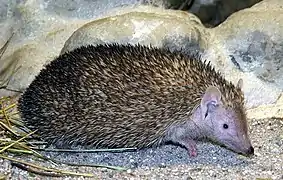


.jpg.webp)

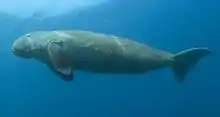

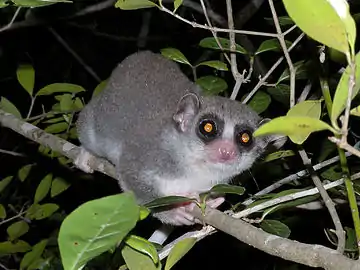
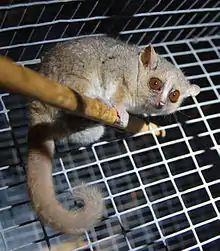



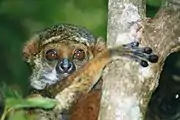
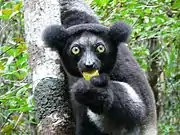
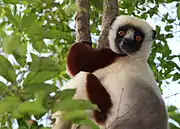

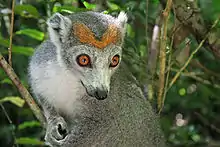

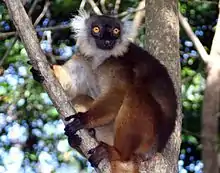
.JPG.webp)
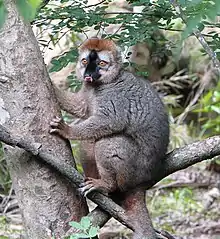
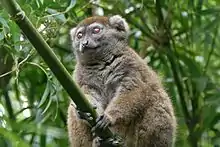
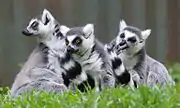
.jpg.webp)
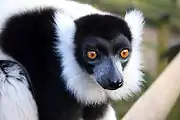
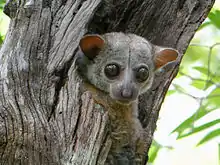
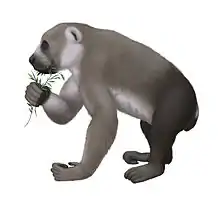

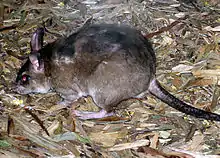
.jpg.webp)
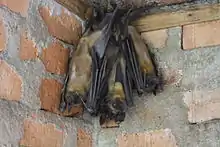
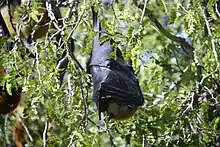
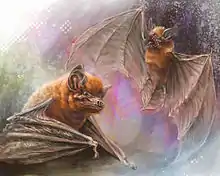

.jpg.webp)

.jpg.webp)
.jpg.webp)


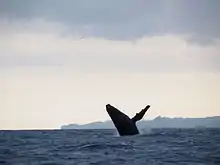

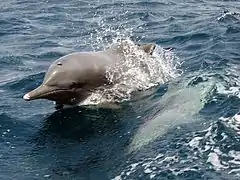
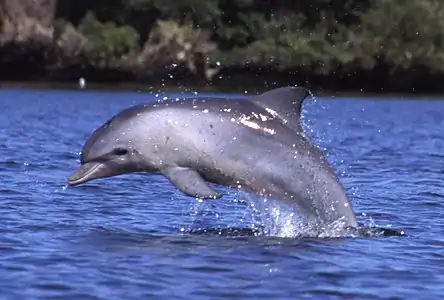
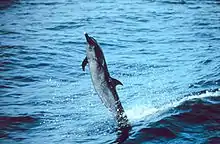
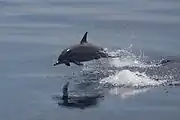

.jpg.webp)
